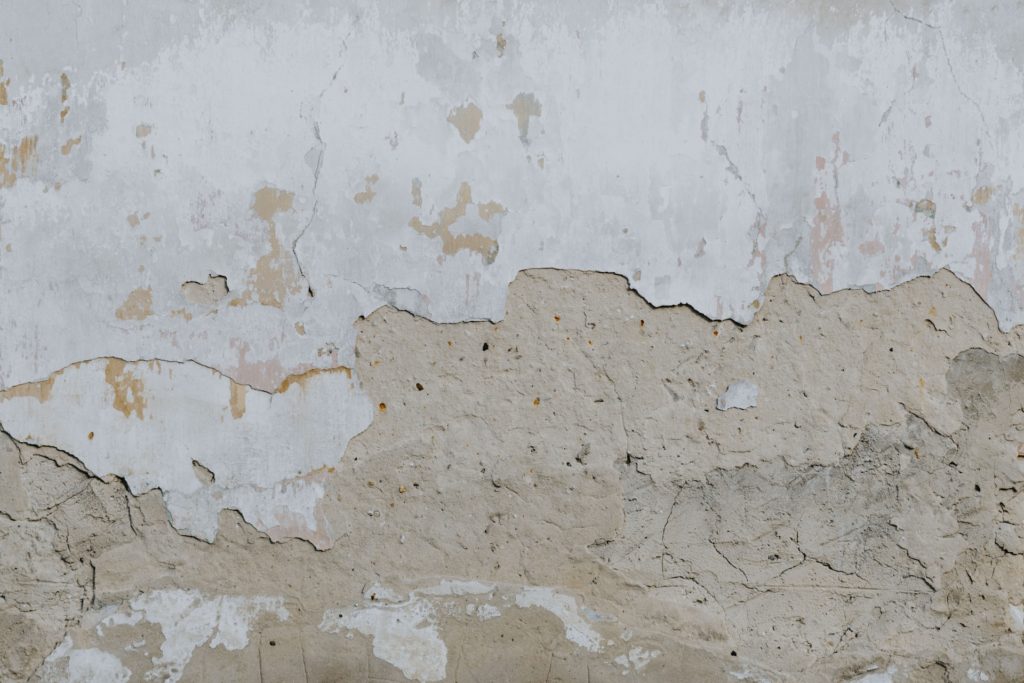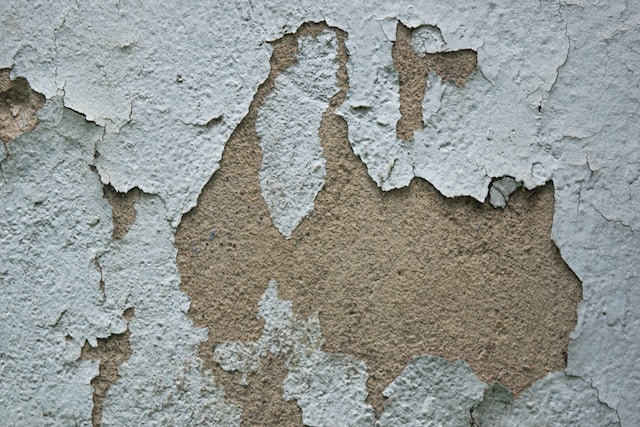Water damage in our homes can be a headache, and one of the most common areas affected is the ceiling. Whether it’s a leaky roof, burst pipes, or other water-related issues, dealing with water-damaged ceilings requires immediate attention and careful handling. However, the process can be challenging and potentially hazardous without the right safety precautions.
Let’s discuss essential safety measures to take when dealing with water-damaged ceilings to protect both yourself and your property.
Signs of Water Damage on Ceilings
1. Watermarks or Brown Rusty Stains
Watermarks or brown, rusty stains on your ceiling are perhaps the most obvious signs of water damage. They often indicate that water has seeped through the roof, plumbing, or other structural components and has left behind visible residue. These stains may vary in size and shape but are typically irregular and darker than the surrounding paint or surface.
2. Mold along the Corners, Ceilings, and Walls
Mold growth is a clear indication of ongoing moisture and water damage. Mold likes to grow in places that are wet and don’t get much light, and ceilings are a great spot for it to grow.
If you notice discolored or fuzzy patches along the ceiling’s corners, edges, or walls, it’s a sign of water intrusion that needs immediate attention.
3. Swollen Ceilings
Ceilings that appear swollen or sagging are another telltale sign of water damage. Excess moisture can cause the ceiling materials to lose their structural integrity, resulting in visible changes to the ceiling’s shape and contour. This is a critical sign as it often implies significant damage.
4. Wallpaper, Baseboards, Trim Separating from Walls
Water damage often affects more than just the ceiling. It can also affect the walls and the junctions where the ceiling, walls, and trim meet. If you notice that wallpaper, baseboards, or trim are separating from the walls or showing signs of warping and damage, it’s likely due to underlying water issues.
5. Sweating Walls
In certain situations, high humidity levels or condensation can cause walls and ceilings to “sweat.” This is often observed as moisture droplets or beads forming on the surface. While it may not be a direct result of external water intrusion, it indicates excessive indoor humidity levels, which can lead to mold growth and other problems.
6. Peeling Paint
Paint that is peeling, blistering, or bubbling on the ceiling suggests that moisture is causing the paint to lose its adhesion. The trapped moisture between the paint and the surface can lead to the paint’s deterioration.
7. Cracks or Bubbles
Water damage can cause the ceiling material to develop cracks, bubbles, or blisters. A weakening of the structure often accompanies these deformities and indicates that the material has absorbed water.
8. Musty Smell
A musty, damp odor in your home, particularly in areas near the ceiling, is a strong indicator of hidden water damage. Even when visible signs are not immediately evident, the presence of an unpleasant odor suggests that water-related issues may be lurking.
Safety Precautions
1. Safety First – Turn Off Electricity
Before you even approach a water-damaged ceiling, ensure that you turn off the electricity to the affected area. Water and electricity are a fatal combination and can lead to electrical shocks or fires. Locate your circuit breaker panel and switch off the power to the affected room or area. If you need help with how to do this, consult with an electrician to ensure your safety.
2. Personal Protective Equipment (PPE)
When dealing with water-damaged ceilings, it’s essential to protect yourself from potential health hazards. Wear appropriate personal protective equipment, including:
Safety goggles: Protect your eyes from debris, dust, and falling materials.
Gloves: Protect your hands from sharp objects and contaminants.
Dust mask or respirator: Prevents inhaling harmful spores, especially if there is mold or mildew present.
3. Open Windows for Ventilation
Proper ventilation is key when working on water-damaged ceilings. If there’s mold or mildew growth, disturbing it can release spores into the air, which can be harmful when inhaled. Open windows and doors to ensure a flow of fresh air. Consider using fans or dehumidifiers to reduce moisture in the area, which can help prevent mold growth.
4. Asbestos Awareness
If your home was built before the 1980s, asbestos-containing materials may have been used in the construction of the ceiling. When water damage occurs in such homes, there’s a risk of asbestos exposure. Disturbing asbestos can be extremely hazardous to your health. If you suspect the presence of asbestos, consult with an asbestos abatement professional immediately before attempting any repairs.
5. Protective Coverings
Before you begin working on the ceiling, protect your belongings below it. Cover furniture and flooring with plastic sheets or tarps to prevent further damage from falling debris, dust, or paint.
6. Ladder Safety
When inspecting or repairing a water-damaged ceiling, you may need a ladder to access the area. Ensure the ladder is stable, on a level surface, and positioned securely before climbing. Always maintain three points of contact on the ladder (e.g., two feet and one hand) to reduce the risk of falls.
Hire Professionals
Dealing with water damage, especially when it affects your ceilings, can be a daunting and stressful experience. From unsightly stains to structural issues and health hazards, water-damaged ceilings can present many challenges. When it comes to addressing these issues, hiring a professional should be your first and foremost choice.
Here are some compelling reasons why hiring a professional to fix water-damaged ceilings is the smart and practical choice:
1. More Skilled and Knowledgeable:
Professionals who specialize in repairing water-damaged ceilings bring a wealth of experience, expertise, and specialized knowledge to the table. They have encountered a wide range of water damage scenarios, and they understand the complexities involved in these situations.
With their in-depth understanding of building structures and materials, they can accurately diagnose the problem and recommend effective solutions.
2. Quick Service
Time is of the essence when dealing with water damage. Professionals are well-equipped to provide quick and efficient service. They have the tools, skills, and resources to address the issue promptly, minimizing the risk of further damage and associated costs.
3. Save Time
Fixing water-damaged ceilings can be a time-consuming task, especially for those without the necessary expertise. Professionals streamline the process, saving you valuable time and allowing you to return to your regular routine sooner.
4. Professional Advice
Beyond the repair work, professionals offer valuable advice and insights into how to prevent future water damage and maintain the integrity of your property. They can recommend necessary improvements, such as roof repairs, plumbing fixes, or improved ventilation, to reduce the risk of recurrent issues. Their professional guidance helps you safeguard your home against future water damage.
5. Equipment and Tools
Experts arrive prepared with the most up-to-date tools and equipment made specifically for restoring areas damaged by water. These tools enable them to detect hidden moisture, remove damaged materials, and restore your ceilings efficiently. Attempting to address water damage without the proper equipment can lead to incomplete repairs and further complications.
6. Minimize Health Risks
When there’s water damage, it can lead to the growth of mold and mildew, and this can be harmful to the health of those living in the house. Professionals understand the health hazards associated with mold and take necessary precautions during the restoration process.
7. Peace of Mind
By hiring professionals, you gain peace of mind knowing that your water-damaged ceilings are in capable hands. You can trust that the problem will be thoroughly resolved and the quality of the repairs will be exceptional.
Ways to Prevent Future Water Damage
Here are some effective ways to prevent future water damage and maintain the integrity of your ceilings:
1. Identify and Address the Root Cause
The primary measure to prevent water damage is to discover and rectify the underlying issue causing it. This could be a leaky roof, faulty plumbing, or poor drainage around your property. Frequently examine your home for potential water entry points, and immediately address any problems you identify. Tackling the underlying problem is crucial to preventing water damage at its source.
2. Regular Maintenance and Inspections
Regular maintenance is key to preventing water damage. Schedule routine inspections of your roof, plumbing, and ceilings to catch any issues before they escalateSearch for indications of aging, like worn-out areas, shingles that aren’t secure, gutters that are blocked, or seals that are getting worse. Early detection and maintenance can save you from costly repairs down the road.
3. Installing Preventative Measures
Invest in preventative measures to protect your home against water damage. Here are a few options to consider:
Gutters and Downspouts: When you have gutters and downspouts set up correctly, they guide rainwater away from your home, stopping it from piling up on the roof or near the foundation. Ensure they are clean and free of debris to maintain their effectiveness.
Roof Repairs: A well-maintained roof is your first line of defense against water intrusion. Repair or replace damaged shingles, flashing, or seals promptly to prevent leaks.
Proper Grading: Ensure the ground around your home slopes away from the foundation. This helps rainwater flow away from the house rather than pooling near it.
Sump Pump: Putting a sump pump in your basement or crawl space can reduce the risk of flooding by removing extra water.
4. Sealing and Waterproofing
Think about sealing and making your ceilings and roof waterproof. This extra step adds more protection to keep water from getting in. Waterproof coatings and sealants are especially effective in areas prone to heavy rainfall or with a history of leaks.
5. Insulate Your Attic
Good insulation in your attic keeps the temperature in your home steady and lowers the chance of ice dams appearing on your roof in winter. Ice dams can make water get stuck under the roof shingles, which can cause harm. Adding insulation to your attic can stop this from happening.
6. Be Cautious with Landscaping
Well-placed landscaping features, such as strategically positioned plants and trees, can help direct water away from your home. However, be mindful not to plant trees too close to your home’s foundation, as their roots can damage the structure and create pathways for water to seep in.
7. Stay Informed
Keep yourself informed about weather conditions and potential flooding risks in your area. Be prepared to take proactive measures, such as sandbagging, during heavy rainfall or flood warnings.
Conclusion
Dealing with water-damaged ceilings is a task that requires careful consideration of safety. Before attempting any repairs, follow the safety precautions we mentioned above. None of them is to be ignored. While addressing water damage is essential, your safety and well-being should always be the top priority. If in doubt, it’s wise to consult with professionals who can assess the situation and recommend the most appropriate course of action.
Call us at Custom Painting, Inc. today for a free evaluation at 510-795-0903 or fill out this contact form, and one of our representatives will call you shortly.





